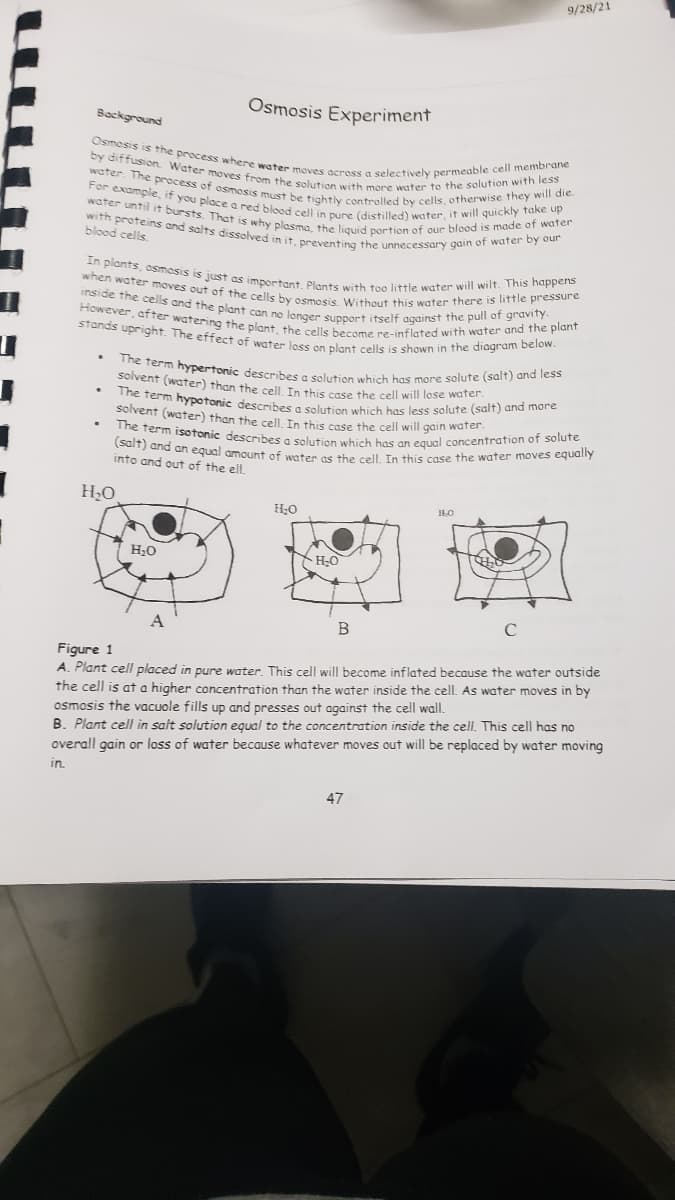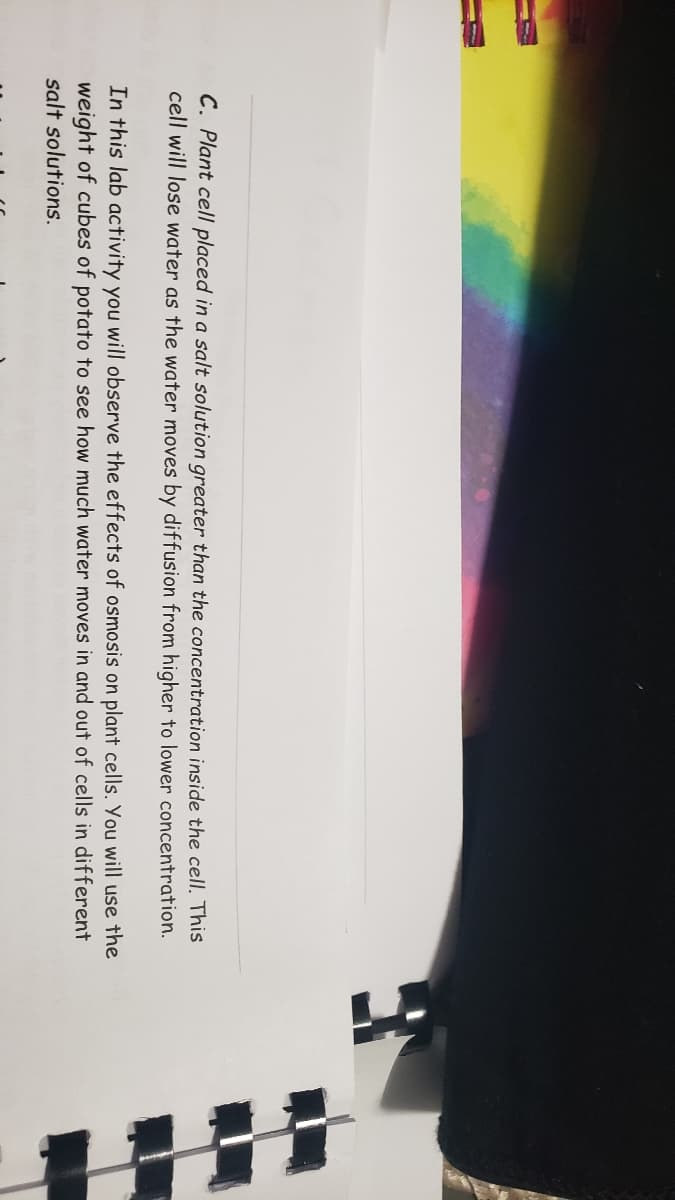Human Anatomy & Physiology (11th Edition)
11th Edition
ISBN:9780134580999
Author:Elaine N. Marieb, Katja N. Hoehn
Publisher:Elaine N. Marieb, Katja N. Hoehn
Chapter1: The Human Body: An Orientation
Section: Chapter Questions
Problem 1RQ: The correct sequence of levels forming the structural hierarchy is A. (a) organ, organ system,...
Related questions
Question
What is the independent variable of the experiment?

Transcribed Image Text:9/28/21
salt) and an equal amount of water as the cell. In this case the water moves equally
For example, if you place a red blood cell in pure (distilled) water, it will quickly take up
The term isotonic describes a solution which has an equal concentration of solute
The term hypertonic describes a solution which has more solute (salt) and less
solvent (wcter) than the cell. In this case the cell will lose water.
The term hypotonic describes a solution which has less solute (salt) and more
Osmosis is the process where water moves across a selectively permeable cell membrane
by diffusion. Water moves from the solution with more water to the solution with less
water until it bursts. That is why plasma, the liguid portion of our blood is made of water
water. The process of osmosis must be tightly controlled by cells, otherwise they will die.
In plants, osmosis is just as important, Plants with too little water will wilt. This happens
stands upright. The effect of water loss on plant cells is shown in the diagram below.
However, after watering the plant, the cells become re-inflated with water and the plant
inside the cells and the plant can no longer support itself against the pull of gravity.
when water moves out of the cells by osmosis. Without this water there is little pressure
with proteins end salts dissolved in it, preventing the unnecessary gain of water by our
Osmosis Experiment
Background
blood cells.
solvent (water) than the cell In this case the cell will gain water-
into and out of the ell.
IŁO
H;0
H-O
A
Figure 1
A. Plant cell placed in pure water. This cell will become inflated because the water outside
the cell is at a higher concentration than the water inside the cell, As water moves in by
osmosis the vacuole fills up and presses out against the cell wall.
B. Plant cell in salt solution equal to the concentration inside the cell. This cell has no
overall gain or loss of water because whatever moves out will be replaced by water moving
in
47

Transcribed Image Text:C. Plant cell placed in a salt solution greater than the concentration inside the cell. This
cell will lose water as the water moves by diffusion from higher to lower concentration.
In this lab activity you will observe the effects of osmosis on plant cells. You will use the
weight of cubes of potato to see how much water moves in and out of cells in different
salt solutions.
Expert Solution
This question has been solved!
Explore an expertly crafted, step-by-step solution for a thorough understanding of key concepts.
This is a popular solution!
Trending now
This is a popular solution!
Step by step
Solved in 2 steps

Knowledge Booster
Learn more about
Need a deep-dive on the concept behind this application? Look no further. Learn more about this topic, biology and related others by exploring similar questions and additional content below.Recommended textbooks for you

Human Anatomy & Physiology (11th Edition)
Biology
ISBN:
9780134580999
Author:
Elaine N. Marieb, Katja N. Hoehn
Publisher:
PEARSON

Biology 2e
Biology
ISBN:
9781947172517
Author:
Matthew Douglas, Jung Choi, Mary Ann Clark
Publisher:
OpenStax

Anatomy & Physiology
Biology
ISBN:
9781259398629
Author:
McKinley, Michael P., O'loughlin, Valerie Dean, Bidle, Theresa Stouter
Publisher:
Mcgraw Hill Education,

Human Anatomy & Physiology (11th Edition)
Biology
ISBN:
9780134580999
Author:
Elaine N. Marieb, Katja N. Hoehn
Publisher:
PEARSON

Biology 2e
Biology
ISBN:
9781947172517
Author:
Matthew Douglas, Jung Choi, Mary Ann Clark
Publisher:
OpenStax

Anatomy & Physiology
Biology
ISBN:
9781259398629
Author:
McKinley, Michael P., O'loughlin, Valerie Dean, Bidle, Theresa Stouter
Publisher:
Mcgraw Hill Education,

Molecular Biology of the Cell (Sixth Edition)
Biology
ISBN:
9780815344322
Author:
Bruce Alberts, Alexander D. Johnson, Julian Lewis, David Morgan, Martin Raff, Keith Roberts, Peter Walter
Publisher:
W. W. Norton & Company

Laboratory Manual For Human Anatomy & Physiology
Biology
ISBN:
9781260159363
Author:
Martin, Terry R., Prentice-craver, Cynthia
Publisher:
McGraw-Hill Publishing Co.

Inquiry Into Life (16th Edition)
Biology
ISBN:
9781260231700
Author:
Sylvia S. Mader, Michael Windelspecht
Publisher:
McGraw Hill Education